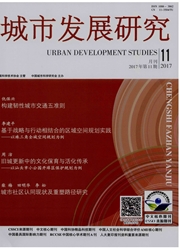

 中文摘要:
中文摘要:
我国山区面积占整个国土面积69.79%,全国有超过一半的人口生活在山区;全国有592个国家级贫困县,其中84%分布在山区。山区的发展直接关系到我国一半的人口脱贫致富,故山区对于我国城镇化整体水平的提升和城乡二元分割的摆脱具有核心性的话语权。由于政策的倾斜和生态环境保护的要求,如今,欠发达山区县交通条件陷入困境,基础设施欠账累累,城镇化水平严重滞后、乡镇空间离散、发展无序。笔者运用相关性分析及分形理论方法,分别从交通网络密度、城乡空间紧凑度及交通设施人均拥有量三方面进行定量测算,明确交通条件的改善对山区县域城镇化发展的影响度。在辨析欠发达山区县城镇化的背景与明确交通发展动力的前提下,指出实现其稳步城镇化的交通发展路径为构建区域联动的宏观交通系统,有效压缩城镇集聚区的同级核聚效应,完善中心区道路网络毛细血管、组织梳理有机生长的边缘交通形式,并按需打造无障碍的绿色旅游通道。
 英文摘要:
英文摘要:
Mountainous area accounts for 69.79% of our country, while more than half of the population lives in the mountains. There are 592 state - level counties throughout the country, and 84% of them distributed in the mountainous area. The development of mountainous area directly related to half of the population in our country. Therefore, the development of mountainous area in our country plays a key role in regional urbanization. Because of the policy and ecological environmental protection requirements, the undeveloped counties in mountainous area are most facing poor traffic condition, low lever urbanization and discrete space structure. In this paper, an empirical research is introduced to discuss problems raised during the carry out of urbanizati on in underdeveloped mountainous counties, which faced with the low-level of urbanization, backward economy, discrete spaces and creaky transport. And impacts from the improving of transportation to the process of urbanization are revealed. It made use of correlation analysis and fractal theory in terms of the density of the network and the spatial compactness. The dynamics of urbanization and development of transport in areas of this type is also sorted out. Finally, a practical pattern is proposed, which is to construct a joint transport for the region to reach to external, and major routes should be highly networked with supplements of roads in the outer-ring, and free access of routes for tourism is necessary for tourism type town.
 同期刊论文项目
同期刊论文项目
 同项目期刊论文
同项目期刊论文
 Exploring Urbanization Patterns for Counties in Underdeveloped Mountainous Areas: A Case Study of Hu
Exploring Urbanization Patterns for Counties in Underdeveloped Mountainous Areas: A Case Study of Hu 期刊信息
期刊信息
